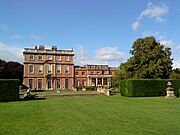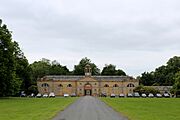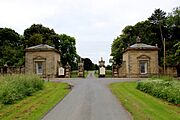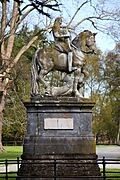Newby Hall facts for kids
Quick facts for kids Newby Hall |
|
|---|---|

"The finest house I saw in Yorkshire"
|
|
| Type | House |
| Location | Skelton-on-Ure, North Yorkshire |
| Built | 1695–1705, with later additions |
| Architect | Sir Christopher Wren (attributed), John Carr and Robert Adam |
| Owner | Richard Compton |
|
Listed Building – Grade I
|
|
| Official name: Newby Hall | |
| Designated | 23 April 1952 |
| Reference no. | 1150307 |
|
Listed Building – Grade I
|
|
| Official name: Stables 150M north of Newby Hall | |
| Designated | 23 April 1952 |
| Reference no. | 1150308 |
|
Listed Building – Grade II
|
|
| Official name: Inner and outer pairs of gate piers, with gates, 50M east of Newby Hall | |
| Designated | 29 October 1987 |
| Reference no. | 1289313 |
|
Listed Building – Grade II
|
|
| Official name: Equestrian statue 150M east of Newby Hall | |
| Designated | 6 March 1967 |
| Reference no. | 1289184 |
|
Listed Building – Grade I
|
|
| Official name: Skelton Lodges to Newby Hall | |
| Designated | 6 March 1967 |
| Reference no. | 1289365 |
| Lua error in Module:Location_map at line 420: attempt to index field 'wikibase' (a nil value). | |
Newby Hall is a grand country house located next to the River Ure in North Yorkshire, England. It is about 3 miles (4.8 km) south-east of Ripon. The land where Newby Hall stands was once owned by the powerful lords of Topcliffe Castle.
Newby Hall is a very important historical building. It is known as a Grade I listed building. Inside, you can see old furniture and beautiful paintings. Outside, there are huge, amazing gardens. Newby Hall is open to the public, so you can visit and explore it!
Contents
The Hall's Story: A Look Back in Time
Long ago, the land of Newby belonged to the lords of Topcliffe Castle. In the 1690s, the Crosland family sold the land to Sir Edward Blackett, 2nd Baronet. He was a Member of Parliament for Ripon.
Sir Edward Blackett tore down the old house and built a brand new mansion in 1697. People believe that famous architect Sir Christopher Wren helped design it. In 1697, a visitor named Celia Fiennes said it was "the finest house I saw in Yorkshire."
Changes and New Owners
After Sir Edward Blackett passed away in 1718, his son, also named Edward, took over. Later, his nephew, another Edward, sold the estate in 1748 to Richard Elcock. The house then went to Richard's young son, William Weddell, in 1762.
William Weddell (1736–1792) was a Member of Parliament. He inherited a lot of money and used it to make Newby Hall even better. During the 1760s, he made the house bigger and updated the inside. Famous architects like John Carr and Robert Adam helped with the new designs.
William Weddell also brought back many ancient Roman statues and artifacts from Italy. These became part of his amazing collection at Newby Hall. When William died in 1792, the estate went to his relative, Thomas de Grey, 2nd Earl de Grey.
The Vyner Family Era
Later, Newby Hall was inherited by Lady Mary Gertrude Robinson. She married Henry Vyner. Lady Mary asked architect William Burges to build the Church of Christ the Consoler on the grounds. This church was built between 1871 and 1876. It was a special memorial for her son, who sadly died in Greece in 1870.
An old statue of King Charles II on a horse was moved to Newby Hall in 1883. It had been changed to show the king stepping on Oliver Cromwell. Other members of the Vyner family, including Henry Frederick Clare Vyner and Robert Charles de Grey Vyner, then owned the hall. In 1915, Mary Evelyn Vyner inherited Newby Hall. She had married Lord Alwyne Compton in 1886.
Newby Hall Today: The Compton Family
The current owners of Newby Hall are the Compton family. They are related to William Weddell. They have worked hard to restore and care for the property.
Amazing Gardens and a Miniature Railway
The beautiful gardens at Newby Hall have many different types of plants. They have long flower borders and lovely woodland paths. Major Edward Compton started developing these gardens into their current form in 1921. His son, Major Robert Edward John (Robin) Compton, continued this work. Robin Compton passed the property to his younger son, Richard, in 1997.
In 1973, a fun miniature railway was built at Newby Hall. It was made even bigger in 1985. The train runs along the riverbank. On Sundays and holidays, a small model of the famous Royal Scot train pulls the carriages. On other days, diesel-powered trains named Countess De Grey or Lady Mary Vyner are used.
Newby Hall on Screen
Newby Hall has been a filming location for several movies and TV shows.
- The 2007 film Mansfield Park was filmed here.
- It was also used for the 2018 movie The Little Stranger.
- In 2020, Newby Hall was featured on an episode of An American Aristocrat's Guide to Great Estates.
- The BBC One show Antiques Roadshow filmed two episodes at Newby Hall in 2020. These episodes were shown in 2021.
In 2016, Gyles Brandreth moved his special Teddy bear museum to Newby Hall. It's a fun place to see many different teddy bears!
The Dogwood Collection
Newby Hall is home to the UK's national collection of Cornus plants, also known as dogwoods. This collection was started in 1990 by Robin Compton. Some of the plants are even older, dating back to the 1930s. The oldest dogwood, a beautiful Cornus kousa, was planted by Robin Compton's father.
Newby Hall's Design
The house is built from red bricks with stone details. It has fancy corners called quoins and decorative railings on the roof. The roofs are made of grey slate. The original building has three floors. The main entrance used to be in the middle, but it's now a window. The current entrance is on the east side. Most of the windows in the house are sash windows, which slide up and down.
Other Interesting Buildings
Skelton Lodges
At the eastern entrance to the Newby Hall grounds, there is a long, balanced set of buildings. In the middle, there are double iron gates. These gates are surrounded by stone pillars and railings. Beyond them are two-story square buildings called lodges. Further along are more walls and smaller lodges. All these parts, including the walls, gates, and lodges, are very important and are listed as Grade I historical buildings.
The Stables
North of the main house, you'll find the stables, which are also a Grade I listed building. They are made of brick, with stone on two sides. The stables form a square shape. The eastern side has a central archway with a rounded top. Above this arch, there is a plaque and a round window. On the roof, there is an octagonal tower with a dome and a fancy weather vane.
Nidd Ferry Disaster Memorial
There is a memorial at Newby Hall that remembers people who were lost in a sad accident. It is made of gritstone and is about 3 meters (10 feet) tall. It has a square base with a rounded arch on each side. Above this, there are columns decorated with grapes. On top, there are four mushroom-shaped decorations and ball-shaped finials. This memorial is listed as a Grade II historical building.
Gallery
-
Equestrian statue of Charles II





